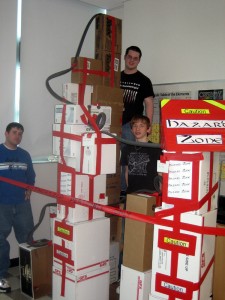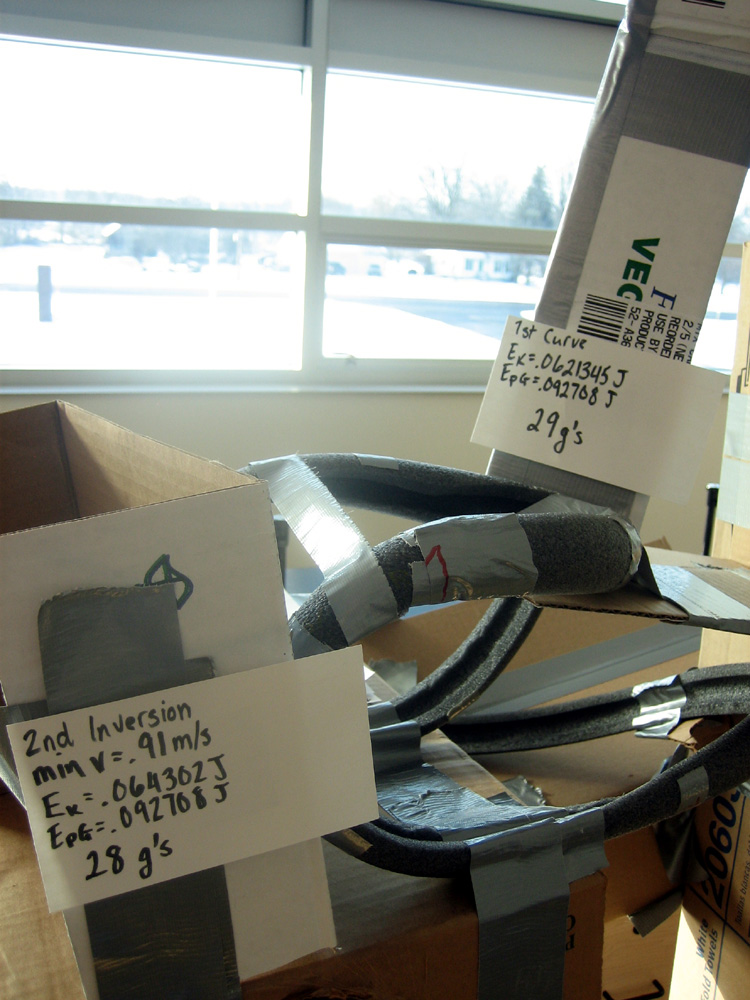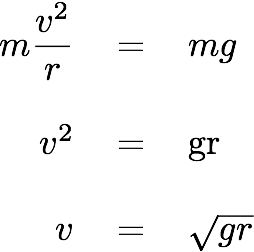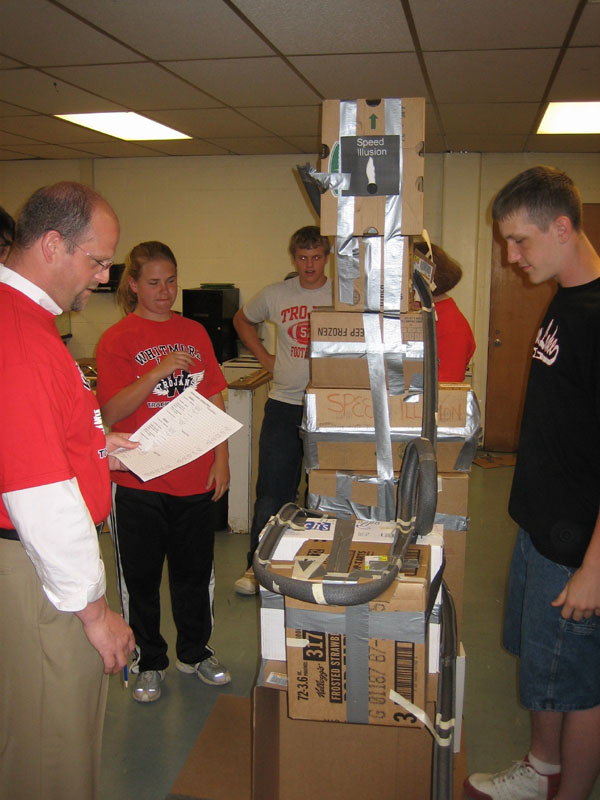Welcome back. If you haven't joined us for the last two posts, let me recommend that you first read about determining rolling friction on the coaster and the project overview.
On to the assessment...
Assessment is extremely important. It explicitly informs students what things we value (and thus the things we value). If we assess the wrong things, students will focus on the wrong things. This can turn an otherwise excellent project into a mediocre project. For this post, I'll share two methods of assessment: First, the "old" method I used when I last taught physics (in 2008). Second, my updated assessment scheme that I'd use if I did this project again.
The old assessment strategy
Embedded below is the document I gave to students at the beginning of the pipe insulation roller coaster project. Most noticeably it includes a description of the assessment scheme I used way back in January of 2008.
[scribd id=73149530 key=key-2h4y3du7bm3b9wfvgt2g mode=list]
As you can see, I split the assessment of this project into two equal parts:
An assessment of the finished roller coaster
I wanted students to think carefully about the design, construction, and "marketing" of their coasters. I wanted them to design coasters that not only met the requirements, but coasters that were beautiful and interesting. Individual items being assessed under this rubric were weighted differently. For example, "Appropriate name of the coaster" was only worth 5%, while "Creativity, originality, and aesthetics" was worth 20%. Here's a link to the sheet I used when assessing this aspect of the coaster project.
An assessment of the physics concepts
In the embedded document above, you can see the breakdown of what items were being assessed. In my last post on pipe insulation roller coasters, you can see how students labeled their coasters with information on the marble's energy, velocity, and such along the track. Groups were required to turn in a sheet with the calculations they performed to arrive at these numbers. These sheets were the primary basis for determining whether students understood the physics concepts.
Problems
There are a lot of problems with the assessment scheme as described above. I'm not going to try to address them all, so here are a couple of the biggest issues:
- Assessing coaster design
- I'm a fan of elegant design. For this project I'm a fan of finished coasters that look well designed and exciting. That's why I included the first part of the assessment. I wanted to incentivize students to think about the design and construction of their coasters. In retrospect this is probably unnecessary. Students generally came into this project with plenty of intrinsic motivation to make their coaster the best in the history of the class. While I'd still stress the importance of quality design in the future, I'd completely cut this half of the assessment. Students already cared about the design of their coaster. If anything, awarding points for coaster design had an net negative effect. Especially because it doesn't assess anything related to the understanding of physics.
- Assessing student understanding of physics concepts
- As a normal part of working in a group while attempting to complete a large project in a limited time, students split up the work. Students are generally pretty smart about this in their own way. While I stressed that everyone in the group should contribute equally towards the calculations. Most groups would have the student who had the best understanding of the physics do most of the calculations. Why? Because it was faster. They needed to finish their coaster and just having the fastest person do the calculations meant more time for construction. While I generally knew when students in a group were adding very little to the calculations (and would assess them accordingly), on the whole this method didn't give me a good picture of each individual students' level of understanding. There were certainly students who skated through the project while minimally demonstrating their understanding of the energy and friction concepts involved.
The new assessment strategy
You've probably already picked up on a few of the improvements I'd make for this project.
- Use standards-based assessment. Standards-based assessment is an integral part of the classroom throughout the year- not just for projects. If you're unfamiliar with what this "standards-based" business is all about click the little number at the end of this sentence for plenty of links in the footnotes1. Here are a list of standards that would be assessed through this project:
Content standards assessed
- Energy
- Understand and apply the law of conservation of energy.
- Explain and calculate the kinetic energy and potential energy of an object.
- Explain and calculate the amount of work done on and by an object.
- Solve basic conservation of energy problems involving kinetic energy and potential energy.
- Solve conservation of energy problems involving work and thermal energy.
- Circular Motion
- Solve basic circular motion problems using formulas.
- Habits of Mind
- Collaborate and communicate with others to meet specific goals.
- Handle and overcome hurdles creatively and productively.
The specific standards used can vary based on your specific implementation.
- No points for coaster requirements. As I mentioned earlier, it proved unnecessary to incentivize their coaster designs and meeting the basic requirements of the project. This decision also comes out of standards-based grading, which focuses assessment around, "Do you know physics?" instead of "Can you jump through the right hoops?" That isn't to say we don't talk about what makes a coaster "exciting" or "aesthetically pleasing" or whatever. It just means a student needs to demonstrate their understanding of the physics to earn their grade.
- A focus on informal assessment. Rather than heavily relying on a sheet of calculations turned in at the end of the project (and probably done lopsidedly by one or two group members) to determine if the group understands the physics, I'd assess their understanding as I walked around the classroom discussing the coasters and their designs with the students as they work on them. Starting with questions like, "Why did you make that loop smaller?," or "Where are you having trouble staying within the requirements?" can be used to probe into student thinking and understanding. The final calculations would still be a part of the assessment, but no longer the single key piece of information in the assessment.
On the whole I was very happy with this project as I used it in the past. As I've learned and grown as a teacher I've found several ways I can tweak the old project to keep up with the type of student learning I want to support in my classroom. If you have other suggestions for improvement, I'd be happy to hear them.
As a bonus, here's a student produced video of the roller coaster project made for the daily announcements. The video was made by a student who wasn't in the physics class, so there's a little more emphasis on the destruction of the roller coasters at the end of the project than I'd like. Kids. What can ya do?
[vimeo http://vimeo.com/32422278 w=500]
- Here are posts I've written about my experience implementing standards-based assessment. I'm not an expert, so let me also direct you my bookmarks related to standards-based grading, and some resources written by a couple people who are more expert: Shawn Cornally and Frank Noschese (who offers blog posts, a shared google doc foler, and a collection of bookmarked links). There are certainly other great resources out there, but these are a great starting point. [↩]








